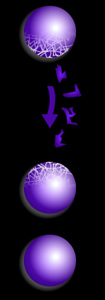Our Mysterious Universe, Part I
 The Banach–Tarski paradox is a theorem in set theoretic geometry which states that a solid ball in 3-dimensional space can be split into a finite number of non-overlapping pieces, which can then be put back together in a different way to yield two identical copies of the original ball. The reassembly process involves only moving the pieces around and rotating them, without changing their shape. However, the pieces themselves are complicated: they are not usual solids but infinite scatterings of points. A stronger form of the theorem implies that given any two “reasonable” objects (such as a small ball and a huge ball), either one can be reassembled into the other. This is often stated colloquially as “a pea can be chopped up and reassembled into the Sun.”
The Banach–Tarski paradox is a theorem in set theoretic geometry which states that a solid ball in 3-dimensional space can be split into a finite number of non-overlapping pieces, which can then be put back together in a different way to yield two identical copies of the original ball. The reassembly process involves only moving the pieces around and rotating them, without changing their shape. However, the pieces themselves are complicated: they are not usual solids but infinite scatterings of points. A stronger form of the theorem implies that given any two “reasonable” objects (such as a small ball and a huge ball), either one can be reassembled into the other. This is often stated colloquially as “a pea can be chopped up and reassembled into the Sun.”
The reason the Banach–Tarski theorem is called a paradox is because it contradicts basic geometric intuition. “Doubling the ball” by dividing it into parts and moving them around by rotations and translations, without any stretching, bending, or adding new points, seems to be impossible, since all these operations preserve the volume, but the volume is doubled in the end.
— Wikipedia, “Banach-Tarski paradox”
Leave a comment